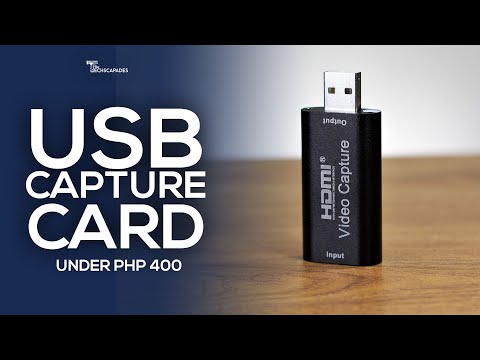
USB Capture Card under ₱400? – Review and Test (WITH CHAPTERS)
What is up guys, and welcome to the Techscapades.
In this video we are going to take a look
at this cheap USB capture card that we purchased
from Shopee.
Out of the box, we were surprised to see that
the capture card itself is made out of metal.
Usually, gadgets at these price ranges tend
to be made with cheap plastic, but this capture
card is surprisingly well built.
The capture card houses a full-size HDMI port
and a full-size USB connector.
Size-wise, the capture card is slightly larger
than an ordinary flash drive and may obstruct
nearby USB ports, so keep that in mind.
This capture card has been largely compared
to the more expensive Elgato Cam Link 4K that
costs 7,500 pesos on Shopee, or you could
scour around the internet and find a cheaper
one like this from Game One PH.
One of the main differences between the Link
4K and this Capture Card is in the name itself
– the Link 4K supports up to 4K at 30 frames,
while the cheap USB capture card is maxed
out to 1080p at 60 frames.
Second is its connectivity, the Link 4K connects
via USB 3 while the USB Card connects via
the older USB 2.
This is
because the 480Mb data rate on USB 2 just
can’t handle 4K without any significant
compression.
Set up is very straightforward, just plug
in the capture card and wait until it appears
as “USB Video” in your application of
choice, whether it’s OBS, Zoom, Google Meet
or Discord.
We tested the capture card by plugging it
in to one of our computers and playing a few
games.
Bit Blaster XL is one of those games that
doesn’t need a quick reaction since it’s
a casual game.
The next game is Dirt 3, a mid-ish game since
a delayed response would definitely hurt your
lap time.
And lastly we have CS:GO, no descriptions
needed.
All of these games worked very well, with
the only downside is that even though latency
is very low, playing from the preview monitor
will really test your skills.
High-end capture cards fix this issue by placing
a passthrough port where you can connect your
monitor but with the flash drive-like form
factor of the USB card, this is not possible.
But this can be easily fixed by buying an
HDMI splitter.
We also tested the USB card on our DSLR camera,
the 5D Mark II, and the video quality is surprisingly
good.
The image is decently sharp, and the colors
are nice and vibrant.
And compared to a webcam this is significantly
better.
And for those who want to use a green screen
background, the higher bit depth of a DSLR
camera would result in a cleaner chroma key
as compared to a cheap webcam – that is
of course, you already own a camera yourself.
But here in FS Digital Studios we found another
use for this cheap USB capture card.
We use it to direct video signal from our
DSLR to an android phone to use the phone
as a video monitor and an external recorder.
Apart from the fact that the card has no passthrough
port, we really have no complains about this
capture card.
Prices do tend to fluctuate in Shopee, but
expect to get one of these under 400 pesos.
If you’re a streamer on a budget, or just
a casual streamer and you don’t want to
spend thousands of pesos, this is the USB
Capture Card for you.
